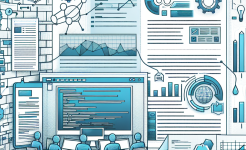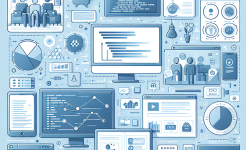Agile Development Model
The Agile development model is characterized by its iterative and incremental approach, emphasizing flexibility, collaboration, and customer feedback. Unlike the Waterfall model, which follows a linear and sequential process, Agile breaks down the project into smaller, manageable units known as sprints. Each sprint typically lasts two to four weeks, during which the team works on a set of prioritized tasks, culminating in a potentially shippable product increment. This approach allows for continuous improvement and adaptation, making it particularly suitable for projects with evolving requirements or uncertain environments.
One of the most significant advantages of the Agile model is its ability to accommodate changes throughout the development process. In traditional models, changes often require extensive rework, leading to delays and increased costs. Agile, however, embraces change, allowing teams to pivot quickly and efficiently. This flexibility is particularly beneficial in industries where market conditions or customer needs are rapidly changing. Additionally, Agile fosters a collaborative environment where cross-functional teams work closely together, enhancing communication and problem-solving capabilities. This collaboration often results in higher-quality products and increased customer satisfaction.
However, the Agile model is not without its challenges. One of the primary difficulties lies in its reliance on constant communication and collaboration. Teams must be highly disciplined and self-organizing, which can be challenging for organizations accustomed to more hierarchical structures. Moreover, the iterative nature of Agile can sometimes lead to scope creep, where the project's scope expands beyond its original objectives. To mitigate this, teams must maintain a strong focus on prioritization and regular reassessment of project goals. Despite these challenges, the Agile model's flexibility and adaptability make it a powerful tool for modern software development.
Waterfall Development Model
The Waterfall development model is a linear and sequential approach, where each phase of the project must be completed before the next one begins. This model is often visualized as a cascading flow, with distinct stages such as requirements gathering, design, implementation, testing, and maintenance. The Waterfall model is well-suited for projects with well-defined requirements and stable environments, where changes are unlikely or can be easily managed. Its structured nature provides a clear roadmap, making it easier to plan and estimate project timelines and costs.
One of the key advantages of the Waterfall model is its simplicity and clarity. Because each phase is completed before moving on to the next, there is a clear understanding of what needs to be done at each stage. This can be particularly beneficial for large, complex projects where a high level of coordination is required. Additionally, the Waterfall model's emphasis on documentation ensures that all aspects of the project are thoroughly recorded, making it easier to track progress and manage risks. This documentation can also be valuable for future projects, providing a reference point for similar endeavors.
However, the Waterfall model's rigidity can also be a significant drawback. Once a phase is completed, it is often difficult and costly to go back and make changes. This can be problematic in projects where requirements are likely to evolve or where there is a high degree of uncertainty. Furthermore, the Waterfall model's linear approach can lead to delays if any phase takes longer than expected, as subsequent phases cannot begin until the previous one is fully completed. Despite these limitations, the Waterfall model remains a viable option for projects with stable and well-understood requirements, where the benefits of structure and clarity outweigh the need for flexibility.
Comparative Analysis

When comparing the Agile and Waterfall development models, it is essential to consider the specific needs and constraints of the project. Agile is best suited for projects where requirements are likely to change, where rapid delivery is critical, and where customer collaboration is paramount. Its iterative approach allows for continuous feedback and improvement, ensuring that the final product meets the customer's evolving needs. On the other hand, the Waterfall model is more appropriate for projects with stable and well-defined requirements, where a structured and predictable process is necessary. Its linear nature provides a clear roadmap, making it easier to manage large, complex projects with multiple stakeholders.
Another critical factor to consider is the level of expertise and discipline within the development team. Agile requires a high degree of collaboration, communication, and self-organization, which can be challenging for teams that are not accustomed to such practices. In contrast, the Waterfall model's structured approach may be more accessible for teams that prefer a more hierarchical and directive style of management. However, it is worth noting that the Waterfall model's rigidity can also be a hindrance, particularly in environments where flexibility and adaptability are essential.
Ultimately, the choice between Agile and Waterfall depends on the specific context of the project. In some cases, a hybrid approach may be the best solution, combining the strengths of both methodologies to create a tailored process that meets the unique needs of the project. For example, a project may begin with a Waterfall approach to establish a clear foundation and then transition to Agile for the implementation and testing phases. This hybrid approach can provide the benefits of structure and flexibility, allowing teams to adapt to changing requirements while maintaining a clear roadmap.
Conclusion
In conclusion, both the Agile and Waterfall development models offer distinct advantages and challenges, making them suitable for different types of projects. Agile's iterative and flexible approach is ideal for projects with evolving requirements and a need for rapid delivery, while Waterfall's structured and linear process is better suited for projects with stable and well-defined requirements. The choice between these methodologies should be based on a thorough analysis of the project's specific needs, the team's expertise, and the desired outcomes. By understanding the strengths and limitations of each model, project managers can make informed decisions that optimize their workflows and increase the likelihood of project success.
FAQ
1.What is the main difference between Agile and Waterfall?
The main difference between Agile and Waterfall lies in their approach to project management. Agile is an iterative and flexible model that allows for continuous feedback and adaptation, while Waterfall is a linear and sequential model that follows a structured, step-by-step process.
2.When should I use Agile over Waterfall?
Agile is best suited for projects where requirements are likely to change, where rapid delivery is critical, and where customer collaboration is essential. It is particularly effective in dynamic environments where flexibility and adaptability are key to success.
3.Can Agile and Waterfall be combined?
Yes, a hybrid approach that combines elements of both Agile and Waterfall can be effective in certain scenarios. For example, a project may begin with a Waterfall approach to establish a clear foundation and then transition to Agile for the implementation and testing phases. This hybrid approach can provide the benefits of both structure and flexibility.
ARTICLE TITLE :Comparative analysis of agile development model and traditional waterfall model ,AUTHOR :ITpmlib

















